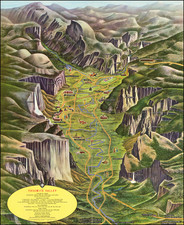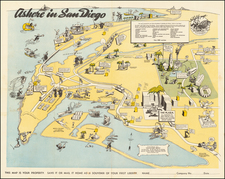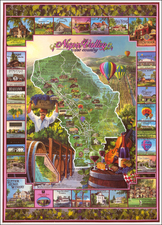This whimsical map illustrates the layout of the International Friendship Gardens in Michigan City, Indiana.
The map is designed not only as a guide but also as an inviting depiction of the gardens' global theme. Central to the map is Lake Lucerne, around which the gardens are organized. Paths wind through areas dedicated to various countries, each presumably showcasing flora and cultural elements from the respective nations. Countries such as Italy, China, Poland, Canada, Australia, and more are represented, indicating a celebration of international diversity and cooperation.
The design of the map suggests an informal and welcoming atmosphere, with "Comfort" and "Woods" flanking the upper corners, conveying areas of rest and natural beauty. Various symbols such as a bridge, amphitheater, and willow nook hint at the recreational and aesthetic experiences available to visitors.
The International Friendship Gardens in Michigan City, Indiana, traces its origins to 1935, inspired by a similar concept at the 1933 Century of Progress International Exposition, a World's Fair held in Chicago. Envisioned as a living monument to the ideals of global harmony and cultural exchange showcased at the fair, the Gardens were established in 1935.
Sprawled across 105 acres, the Gardens emerged as a cross-cultural sanctuary, intertwining the natural beauty of the Midwest with the diverse horticultural traditions of the world. Each of the 14 ethnic gardens within its bounds was meticulously designed to reflect the distinctive landscapes and flora associated with different nations, from the serene rock gardens of Japan to the classical formal gardens of France, thereby creating a botanical atlas that visitors could traverse within mere hours.
Central to the International Friendship Gardens was the Theater of Nations, an innovative stage that echoed the global ethos of the Gardens themselves. This unique performance space, encircled by the ethnic gardens, became a focal point for cultural presentations, from traditional dances to music that resonated with the heritage of the represented countries, promoting cultural understanding and appreciation among the audiences.
The Gardens flourished through the mid-20th century, becoming a place where the local community and visitors could immerse themselves in a world of international traditions, art, and nature.












![[ Original Artwork - 37 Hand Drawn Maps By Norton Allen For Desert Magazine ]](https://storage.googleapis.com/raremaps/img/small/99899.jpg)

![The Seasoned Traveler Goes By Train [Map of Denver and Rocky Mountain National Park]](https://storage.googleapis.com/raremaps/img/small/99861.jpg)